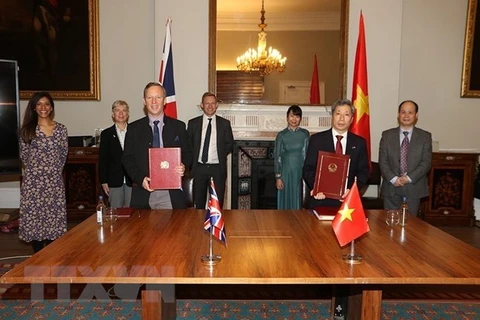 Vietnamese firms have capitalised on the signed free trade deals to boost exports. (Photo: VietnamPlus)
Vietnamese firms have capitalised on the signed free trade deals to boost exports. (Photo: VietnamPlus) Hanoi (VNA) - Vietnam has been making good use of advantages of the international economic integration process, helping increase the country’s exports by 22 percent year-on-year and imports by 26 percent in the first quarter of 2021, said Tran Thanh Hai, Deputy Director of the Agency of Foreign Trade under the Ministry of Industry and Trade.
Talking to the press, Hai said the EU-Vietnam Free Trade Agreement (EVFTA), the UK-Vietnam Free Trade Agreement (UKVFTA) and the Comprehensive and Progressive Agreement for Trans-Pacific Partnership (CPTPP) have become effective, and the Regional Comprehensive Economic Partnership (RCEP) is about to come into effect.
Processed products brought home 67.39 billion USD during January – March, accounting for 87.13 percent of the total export turnover. Several products posting high export revenue, including telephone and parts (14.08 billion USD); computer, electronic product and parts (11.96 billion USD); and machine, equipment, tool and parts (9.1 billion USD).
In the meantime, exports of agro-forestry-fishery products, despite hit hard by COVID-19, inched up 6.6 percent to some 5.97 billion USD. Standout export growth was seen in rubber (up 89.7 percent in volume and 16.5 percent in revenue), and cassava and cassava products (up 40.3 percent in volume and 53.2 percent in revenue).
In the three-month period, Vietnam splashed out 75.31 billion USD on imports, a year-on-year rise of 26.3 percent.
Selling 23.8 billion USD worth of goods to Vietnam, China was the largest exporter of the Southeast Asian nation, followed by the Republic of Korea (13 billion USD), ASEAN (9.7 billion USD), Japan (5.1 billion USD), and EU (4.1 billion USD).
Vietnam purchased 66.1 billion USD worth of materials for domestic production, which means local firms have been ready for a new business cycle post pandemic.
The country achieved a trade surplus of 2.03 billion USD in the first quarter, with both exports and imports rising sharply.
For the EU market, several Vietnamese commodities have enjoyed incentives of the EU’s Generalised System of Preferences (GSP) for years.
 Deputy Director of the Agency of Foreign Trade under the Ministry of Industry and Trade Tran Thanh Hai (Photo: VietnamPlus)
Deputy Director of the Agency of Foreign Trade under the Ministry of Industry and Trade Tran Thanh Hai (Photo: VietnamPlus)
However, for the long term, taking advantage of opportunities brought about by the EVFTA is a sustainable and equal preference. Specially, for the commodities that Vietnam has advantage, they can enjoy preferences on origins combined in the EVFTA, Hai said.
He advised enterprises to bring into full play advantages of the agreement by understanding the advantages for their commodities and then change their production process and material supply to meet requirements of origin.
Looking back on the import-export figures in the first quarter, Hai said, electronic products, electric appliances and furniture are the most benefitted as increasing demand from the European and North American markets.
However, such products as garment and textiles and footwear are facing difficulties caused by the disruption of the supply chains.
Although Vietnamese enterprises showed their ability during the COVID-19 year of 2020, they should outline more comprehensive measures to reduce loss and take advantage of the possible instable factors, Hai highlighted.
| Market shares of Vietnam's major exports to the European Union (EU) are expected to surge as exporters will enjoy preferential treatment under the bloc's Generalised System of Preferences (GSP). From 2014 onward, more Vietnamese products, including footwear, may gain further benefits under the new GSP regulations. The EU published its amended GSP regulations in October 2012, and they came into effect at the beginning of this year. The regulations are aimed at facilitating market access for goods originating from developing countries, including Vietnam. Vietnam will remain in the list of countries eligible to enjoy preferential treatment under the EU's GSP, with a number of favourable tariffs. GSP rules will help improve Viet Nam's access to the EU market, speed up industrialisation, create jobs and increase incomes, as well as contribute to economic growth. |























